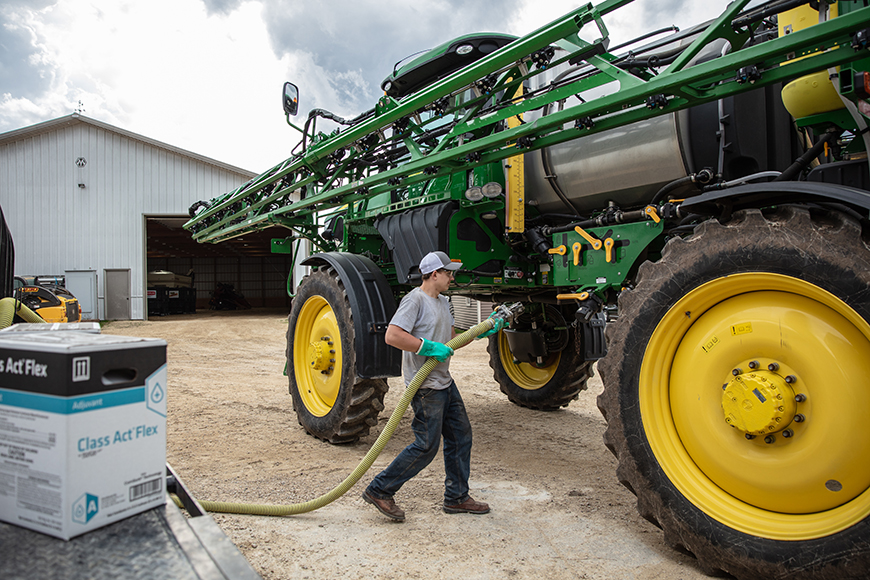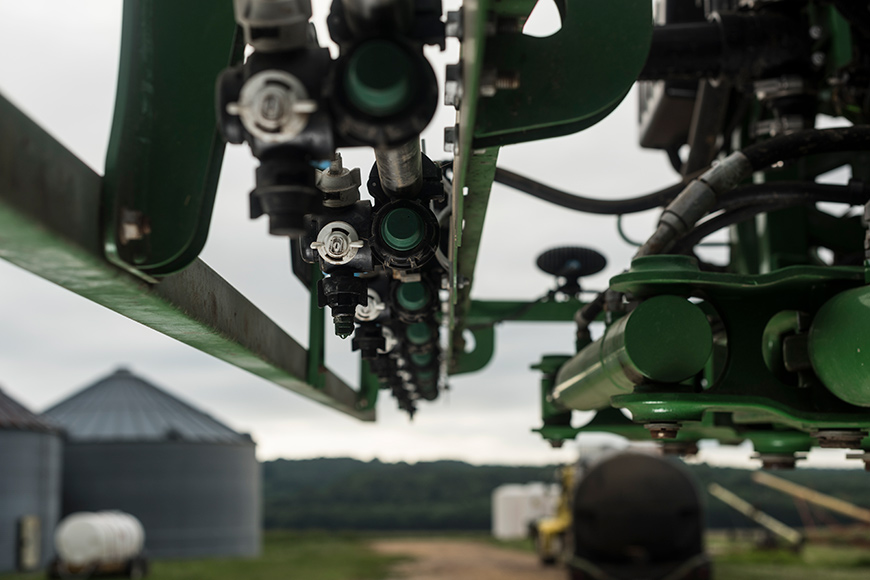Prevent and Control Herbicide-Resistant Weeds

If you find your herbicides aren’t performing as well as they used to, you may be battling herbicide-resistant weeds. Once you have resistant weeds, it becomes much more challenging and costly to keep fields clean. With a diversified weed control program, you can level up your weed management strategy and reduce the risk of resistant weed populations developing in your fields.
How do weeds become resistant to herbicides?
Like all biological organisms, weed populations include genetically diverse individuals called biotypes. Some weeds in a population are naturally more tolerant of specific herbicides based on genetics. When you spray a single mode of action or apply sub-lethal herbicide rates to a field, you kill weeds most susceptible to those herbicides, but weeds with higher tolerance are left in fields to reproduce.
Over time and with repeated applications of the same mode of action, those herbicide-tolerant weeds become more prevalent in the field, leading to resistant populations that are difficult to control. Herbicide resistance can develop rather quickly in some cases. For example, resistance to sulfonylurea herbicides has been reported after just three to five years of repeated use.
What can be done to slow herbicide resistance?
I recommend several management strategies to prevent or slow the development of herbicide-resistant weed populations.
Use multiple modes of action
Agronomists have been recommending multiple modes of action for weed control for many years, and it’s still the number one strategy for preventing herbicide-resistant weeds. When you use multiple, effective modes of action against targeted weeds, they’re less likely to evade control. For example, if you’re using a herbicide with three modes of action, the likelihood that a weed is resistant to all three is very low. The Take Action Herbicide Classification guide is a good resource for identifying premix herbicides with multiple modes of action as you plan your herbicide applications.
Use appropriate herbicide rates
When you use a sub-lethal dose of a herbicide, you inadvertently select for herbicide-tolerant weed biotypes. A sub-lethal rate may stunt weeds with a natural tolerance to the herbicide, but they won’t be fully controlled. That enables weeds to reproduce and pass herbicide-tolerant genes on to the next generation, increasing the percentage of resistant weeds in your field. Always follow labeled herbicide rates and adjust based on your field conditions and weed pressure.
Consider using a two-pass herbicide application program
If you’re using a one-pass herbicide program, adding a second application can add another layer of defense against herbicide resistance. Even if your herbicide has multiple modes of action, sub-lethal doses or unfavorable weather conditions can limit herbicide coverage and weed control. That encourages the selection of herbicide-tolerant weeds, so I strongly advocate for a two-pass system. In general, the first herbicide spray should happen shortly before or at planting, and the second pass should come 21 to 28 days later when the corn crop is at the V2 to V3 growth stage.
What should you do if you suspect herbicide-resistant weeds in your fields?
If you notice your herbicides aren’t achieving adequate weed control, resistant weed populations could be to blame. Here are a few actions to take to limit the threat to your crop.
Adopt alternative chemistries
If you suspect herbicide-resistant weed populations, you’ll want to start looking at other effective modes of action against the weeds you’re trying to control. For example, if you know you have glyphosate-resistant pigweed or waterhemp in your fields, consider switching to glufosinate to improve weed control.
Use good spray practices
Your spray practices play a critical role in managing herbicide-resistant weeds. For example, adding complementary adjuvants to the tank mix can achieve a more consistent spray coverage, which helps enhance herbicide efficacy.
A deposition aid and drift reduction agent, such as InterLock® adjuvant, can help optimize spray droplet size to help ensure herbicide active ingredients get to weed targets. Water conditioners, such as Class Act® NG® adjuvant, help tie up antagonistic ions in water that can reduce a herbicide’s efficacy.
Finally, oil-based surfactants, such as StrikeLock® and Destiny® HC adjuvants, are excellent options for helping increase foliar uptake of herbicides, especially under stressful conditions.
It's also crucial to use spray nozzles appropriate for the chemistry you plan to apply. For example, some herbicides, including low-volatility dicamba and 2,4-D formulations, have very specific nozzle specifications as required by the label. Glufosinate requires very fine droplets, while other postemergence corn herbicides accommodate larger droplet sizes. Be sure you have appropriate nozzles stocked for each herbicide you plan to spray to optimize spray application efficacy.
Consider tillage
If tillage is an option, it’s an excellent way to get solid early-season weed control and take the pressure off herbicide applications. While vertical tillage has become popular for seedbed preparation, you need more aggressive early-season tillage to manage weeds effectively. Remember that tillage may increase the emergence of problematic weeds that come up after planting, so you’ll need to have a plan to control them.
Weeds will continue to evolve strategies to evade control, making a diversified weed management program crucial to protect your crops. Your WinField United retailer can help you develop an effective plan.
All photos are either the property of WinField United or used with permission.
© 2023 WinField United. Important: Before use always read and follow label instructions. Crop performance is dependent on several factors many of which are beyond the control of WinField United, including without limitation, soil type, pest pressures, agronomic practices and weather conditions. Growers are encouraged to consider data from multiple locations, over multiple years and to be mindful of how such agronomic conditions could impact results. Class Act, NG, Destiny, InterLock, StrikeLock and WinField are trademarks of WinField United. All other trademarks are the property of their respective owners.
How do weeds become resistant to herbicides?
Like all biological organisms, weed populations include genetically diverse individuals called biotypes. Some weeds in a population are naturally more tolerant of specific herbicides based on genetics. When you spray a single mode of action or apply sub-lethal herbicide rates to a field, you kill weeds most susceptible to those herbicides, but weeds with higher tolerance are left in fields to reproduce.
Over time and with repeated applications of the same mode of action, those herbicide-tolerant weeds become more prevalent in the field, leading to resistant populations that are difficult to control. Herbicide resistance can develop rather quickly in some cases. For example, resistance to sulfonylurea herbicides has been reported after just three to five years of repeated use.
What can be done to slow herbicide resistance?
I recommend several management strategies to prevent or slow the development of herbicide-resistant weed populations.
Use multiple modes of action
Agronomists have been recommending multiple modes of action for weed control for many years, and it’s still the number one strategy for preventing herbicide-resistant weeds. When you use multiple, effective modes of action against targeted weeds, they’re less likely to evade control. For example, if you’re using a herbicide with three modes of action, the likelihood that a weed is resistant to all three is very low. The Take Action Herbicide Classification guide is a good resource for identifying premix herbicides with multiple modes of action as you plan your herbicide applications.
Use appropriate herbicide rates
When you use a sub-lethal dose of a herbicide, you inadvertently select for herbicide-tolerant weed biotypes. A sub-lethal rate may stunt weeds with a natural tolerance to the herbicide, but they won’t be fully controlled. That enables weeds to reproduce and pass herbicide-tolerant genes on to the next generation, increasing the percentage of resistant weeds in your field. Always follow labeled herbicide rates and adjust based on your field conditions and weed pressure.
Consider using a two-pass herbicide application program
If you’re using a one-pass herbicide program, adding a second application can add another layer of defense against herbicide resistance. Even if your herbicide has multiple modes of action, sub-lethal doses or unfavorable weather conditions can limit herbicide coverage and weed control. That encourages the selection of herbicide-tolerant weeds, so I strongly advocate for a two-pass system. In general, the first herbicide spray should happen shortly before or at planting, and the second pass should come 21 to 28 days later when the corn crop is at the V2 to V3 growth stage.
What should you do if you suspect herbicide-resistant weeds in your fields?
If you notice your herbicides aren’t achieving adequate weed control, resistant weed populations could be to blame. Here are a few actions to take to limit the threat to your crop.
Adopt alternative chemistries
If you suspect herbicide-resistant weed populations, you’ll want to start looking at other effective modes of action against the weeds you’re trying to control. For example, if you know you have glyphosate-resistant pigweed or waterhemp in your fields, consider switching to glufosinate to improve weed control.
Use good spray practices
Your spray practices play a critical role in managing herbicide-resistant weeds. For example, adding complementary adjuvants to the tank mix can achieve a more consistent spray coverage, which helps enhance herbicide efficacy.
A deposition aid and drift reduction agent, such as InterLock® adjuvant, can help optimize spray droplet size to help ensure herbicide active ingredients get to weed targets. Water conditioners, such as Class Act® NG® adjuvant, help tie up antagonistic ions in water that can reduce a herbicide’s efficacy.
Finally, oil-based surfactants, such as StrikeLock® and Destiny® HC adjuvants, are excellent options for helping increase foliar uptake of herbicides, especially under stressful conditions.
It's also crucial to use spray nozzles appropriate for the chemistry you plan to apply. For example, some herbicides, including low-volatility dicamba and 2,4-D formulations, have very specific nozzle specifications as required by the label. Glufosinate requires very fine droplets, while other postemergence corn herbicides accommodate larger droplet sizes. Be sure you have appropriate nozzles stocked for each herbicide you plan to spray to optimize spray application efficacy.
Consider tillage
If tillage is an option, it’s an excellent way to get solid early-season weed control and take the pressure off herbicide applications. While vertical tillage has become popular for seedbed preparation, you need more aggressive early-season tillage to manage weeds effectively. Remember that tillage may increase the emergence of problematic weeds that come up after planting, so you’ll need to have a plan to control them.
Weeds will continue to evolve strategies to evade control, making a diversified weed management program crucial to protect your crops. Your WinField United retailer can help you develop an effective plan.
All photos are either the property of WinField United or used with permission.
© 2023 WinField United. Important: Before use always read and follow label instructions. Crop performance is dependent on several factors many of which are beyond the control of WinField United, including without limitation, soil type, pest pressures, agronomic practices and weather conditions. Growers are encouraged to consider data from multiple locations, over multiple years and to be mindful of how such agronomic conditions could impact results. Class Act, NG, Destiny, InterLock, StrikeLock and WinField are trademarks of WinField United. All other trademarks are the property of their respective owners.





.jpeg?ext=.jpeg)